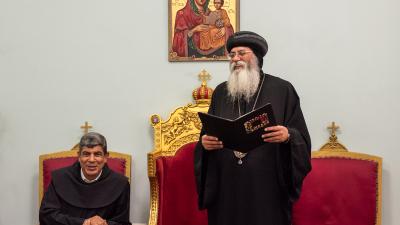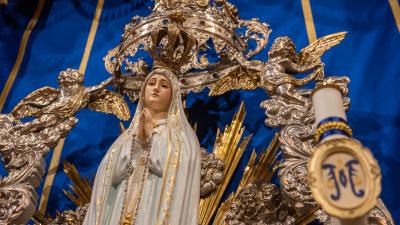
A cheerful chatter fills the rooms on the ground floor of the Franciscan Shrine in Emmaus Qubeybeh. These are the children at the nursery school of the Custody of the Holy Land that since 1986 has been a landmark for the whole village. In the managing room sits Sister Bonifacia, a Filipino nun of the missionaries of the catechism, who [affectionately] goes by Bonny. “For over 30 years, since Emmaus was the home of those aspiring to attend the seminary of the Custody of the Holy Land, I have been here,” she said. Three instructors, a teacher who provides support on special occasions, and a sociologist who comes twice a month manage the activities. Sister Bonifacia is in charge of managing the teachers and the school. The shrine at Emmaus was recognized as the place where Jesus appeared to the two disciples on their way from Jerusalem after his resurrection. Two Franciscan friars guard the site, along with the collaboration of the Sisters of Cathechism, who manage the nursery school. .
The relationship between friars, sisters and the local community is very positive. “The purpose of this nursery school has always been to seek contact with Muslims and to have a good relationship with them,” said Sister Bonifacia. Today, the school has 54 children enrolled, all of whom are from Muslim families, although at the beginning of the year there were 64 [of them]. “Many have stopped attending, which happens every year,” said Fr. Salem Younis, guardian of Emmaus Shrine. Fr. Salem is the legal representative of the school and so he works daily with Sister Bonifacia. “We have two other nursery schools in the village, but there are many children [also] coming from nearby villages. We do not have any specific issues currently, except for the fact that we always need to replace the children’s supplies and games.”
The Custody of the Holy Land provides support for the school, paying the employees’ salaries and providing the spaces located in a part of the large Emmaus convent. The children are split up into three different large classrooms by age groups, and there are then other rooms available as well. Among the child-sized desks and chairs, the little ones move about chaotically, with the energy that sets those apart who are discovering the world day in and day out. However, when a guest arrives, each child sits in his or her seat and tries to act serious. “Ahlan wa sahlan marhabten”: the energy of the children turns into a lively welcoming choir.
The school’s commitment to helping the young pupils can be seen daily as it strives to penetrate the local mentality and fight hatred. “We instruct our teachers to tell the children that here they are brothers and sisters who must love each other,” Sister Bonifacia said with conviction. “I myself say to the children, ‘You must love yourself because you are a family.’” Two of the teachers are also Muslims, while the third is part of the last Christian family left in Emmaus. “Here we do not try to teach our religion; we do not catechize, but we want to provide a witness to love,” said the principal.
At the ringing of the bell, the [all of the children] together yell vivaciously and the rush to the door with their little book bags on their backs.
Beatrice Guarrera
Related articles
Saints Simeon and Cleophas: Mass at Emmaus al-Qubeybeh and the opening of the Terra Sancta Organ Festival
Turning our lives into a way to Emmaus
Passing through Emmaus el-Qubeibeh




